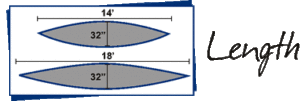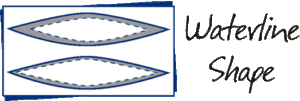Choosing the right canoe is a highly personal decision. The “best” canoe for some may not even come close to your ideal hull, because it all depends on the way you intend to use it. With so many different hulls designed for a multitude of uses, it may seem like a daunting task at first – but it’s not that hard. It does take more than buying based on price alone. A bit of study should reveal a canoe that will serve you well for 20 years or more.
We like to break things down into three areas when shopping for a canoe:
-
1. Canoe Categories
Touring Canoes – A blend of all types of performance Touring canoes are the most popular and should be considered by everyone first. They are medium in length, generous in width and depth, have a shallow-arch bottom and only an inch or two of front-to-back rocker. These aspects make good touring hulls track well, travel easily and carry a fair load.
Recreational Canoes – Steady, maneuverable and easy to control. Paddlers who enjoy photography, bird-watching, fishing and hunting prefer a solid, stable canoe for peace of mind. These hulls are shorter, wider, and have full bottoms for a solid “foot print” in the water. They’re made for paddlers who seldom go long distances, carry much gear or face large waves.
Performance Canoes – Efficient to paddle for long or short trips. These canoes deliver easy speed and long glide, with significant capacity when needed. Performance hulls are generally longer, a bit slimmer and not overly deep. Although performance designs don’t strictly require skilled paddlers, they will perform best in experienced hands.
Expedition Canoes – Big displacement for high capacity, these are the largest canoes, excelling in at least two dimensions, of which length should be one. They haul more weight than other designs, and do it safely on vast lakes, big rivers and tidal waters where waves can be massive. In addition to conquering challenges, they also serve well for day use and trips by sizeable families.
River Touring Canoes – Extremely maneuverable, dry and buoyant. While Touring canoes are versatile craft that paddle well in rivers, they excel in calmer waters. River Touring canoes excel in fast rivers but can also be paddled in lakes. They often have significant front-to-back rocker to improve maneuvering in fast waters, and generous flair and depth to tackle whitewater confidently.

-
2. Canoe Design
When selecting a canoe, it’s helpful to know the basic theory of hull design. This can be distilled down into the basics of Length, Width, Depth, Waterline Shape and Rocker.
 Comparing two canoes that have the same width, a longer one is more streamlined than a shorter one. Even though it’s larger, the longer hull travels faster with less effort, glides farther for each stroke, and carries more weight with less loss of performance when heavily loaded.
Comparing two canoes that have the same width, a longer one is more streamlined than a shorter one. Even though it’s larger, the longer hull travels faster with less effort, glides farther for each stroke, and carries more weight with less loss of performance when heavily loaded.
 The important measures of width are: maximum at the gunwales, maximum overall, and maximum at the water. Waterline width has a large impact. A wider hull tends to be steadier, but it will require more effort to paddle. (For a solo canoe, the overall width influences how easy or difficult it is to reach the water with the paddle.)
The important measures of width are: maximum at the gunwales, maximum overall, and maximum at the water. Waterline width has a large impact. A wider hull tends to be steadier, but it will require more effort to paddle. (For a solo canoe, the overall width influences how easy or difficult it is to reach the water with the paddle.)
 The significant measures of depth are: bow, center, and stern depth. Greater center depth quickly adds volume and seaworthiness. Greater bow or stern depth mainly helps to combat waves or spray. If a canoe is a V-type hull or has a keel, the depth dimensions likely include it, and if so, the canoe is not functionally as deep as the dimensions suggest.
The significant measures of depth are: bow, center, and stern depth. Greater center depth quickly adds volume and seaworthiness. Greater bow or stern depth mainly helps to combat waves or spray. If a canoe is a V-type hull or has a keel, the depth dimensions likely include it, and if so, the canoe is not functionally as deep as the dimensions suggest.
 Hulls that look alike from above may be shaped quite differently at the waterline. Of the two canoes shown, the top one is effectively shorter. The bottom one is longer at the waterline and will paddle more efficiently. To predict performance, try to envision a canoe’s shape at the water.
Hulls that look alike from above may be shaped quite differently at the waterline. Of the two canoes shown, the top one is effectively shorter. The bottom one is longer at the waterline and will paddle more efficiently. To predict performance, try to envision a canoe’s shape at the water.

A hull with rocker acts shorter than it is because the bow and stern aren’t as deep in the water as the center is. Or, the ends may be out of the water almost completely. A rockered hull turns more easily but won’t track or perform as well.

-
3. Canoe Materials
What a canoe is made from is an important consideration. Weight, durability, and dependability are all important factors to consider when choosing a hull material. Below are the materials popular today:
Wood Canoes – Wood canoes can be of edge-glued cedar-strip construction, or a wood frame skinned with fabric. Both types are very laborious to build, but wood construction allows the creation of fine-performing canoes. It is almost guaranteed that any wood canoe will demand intensive maintenance.
Aluminum Canoes – Unlike wood construction, aluminum cannot produce fine-performing canoes. The properties of the material impose limits, as does the manufacturing process. These canoes are heavy and slow but are very durable – a fact that makes them very popular with outfitters and canoe rental liveries.
Polyethylene Canoes – Rotomolded polyethylene canoes currently occupy the lowest tier of pricing available in canoes (these are the ones you’ll most likely find in the rafters at discount retailers). In comparison to T-Formex, these boats tend to be less stiff and they certainly lack some of the appearance features. When considering plastic canoes, T-Formex is still the best value.
T-Formex Canoes – Lighter than polyethylene and aluminum canoes, T-Formex canoes are incredibly tough, making them the ideal choice for sportsman, whitewater paddlers, families or kids, or anyone who wants a durable canoe. While not permitting the elegance possible with wood or composites, T-Formex canoes can deliver good efficiency and handling. Under almost any circumstances, these canoes are greatly superior to aluminum or polyethylene.
Composite Canoes – A huge field, more canoe builders use composites, and more models are made of them than any other material by far. Composite canoes are constructed using multiple layers of material (fiberglass, Kevlar, graphite, etc) which are formed in a mold and bonded with resins to make a tough, lightweight hull. Good composite canoes, being all hand-built, aren’t cheap – but their lightness, toughness, and performance can make them among the very best values.



